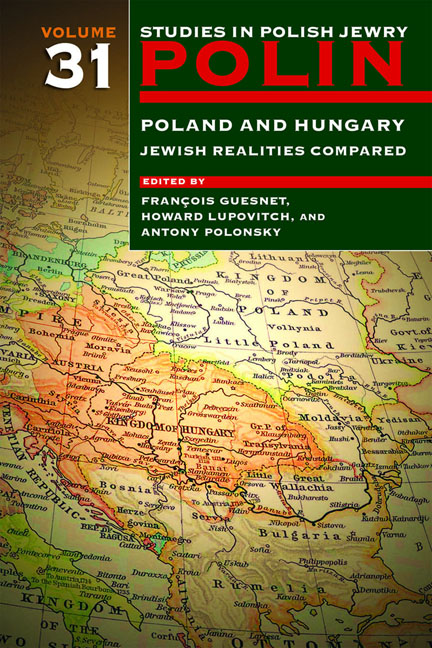Book contents
- Frontmatter
- Dedication
- Editors and Advisers
- Preface
- Polin
- Polin: Studies in Polish Jewry
- Contents
- Note on Place Names
- Note on Transliteration
- Part I POLAND AND HUNGARY: JEWISH REALITIES COMPARED
- JEWISH ACCULTURATION AND INTEGRATION
- JEWISH RELIGIOUS LIFE
- JEWS IN POPULAR CULTURE
- THE INTERWAR YEARS
- THE HOLOCAUST AND ITS AFTERMATH
- PERSONAL REFLECTIONS
- Part II NEW VIEWS
- Part III OBITUARIES
- Notes on the Contributors
- Index
Between Poland and Hungary: The Process of Jewish Integration From a Comparative Perspective
- Frontmatter
- Dedication
- Editors and Advisers
- Preface
- Polin
- Polin: Studies in Polish Jewry
- Contents
- Note on Place Names
- Note on Transliteration
- Part I POLAND AND HUNGARY: JEWISH REALITIES COMPARED
- JEWISH ACCULTURATION AND INTEGRATION
- JEWISH RELIGIOUS LIFE
- JEWS IN POPULAR CULTURE
- THE INTERWAR YEARS
- THE HOLOCAUST AND ITS AFTERMATH
- PERSONAL REFLECTIONS
- Part II NEW VIEWS
- Part III OBITUARIES
- Notes on the Contributors
- Index
Summary
IN THE WAKE of the First World War Poland and Hungary became independent states. Poland, which for some 130 years had been partitioned between its neighbouring empires—Russia, Austria, and Prussia—now gained independence, including in its territory some predominantly Ukrainian and Belarusian areas which had been part of the Polish–Lithuanian Commonwealth. Hungary, which had enjoyed extensive autonomy since the Ausgleich (Austro-Hungarian Compromise) of 1867, was now severed from the defunct Habsburg empire and became independent, but its boundaries were dramatically reduced as a result of the Treaty of Trianon. The two states, whose independence was part of a new European order based on the principle of national self-determination, were supposed to function as democracies and respect the rights of their minorities. In the immediate aftermath of ‘the war to end all wars’, there was reason to hope that the recognition of the Jews as equal citizens would lead to a golden age of Jewish integration. In practice, the reality was different. Both Poland and Hungary were established as independent states amidst violent internal and external conflicts over their boundaries and the nature of their regimes. In both states, these struggles, which continued throughout the whole interwar period, increasingly led to the dominance of an exclusionary nationalism. Jews were the central, although not the only, minority targeted by this policy of exclusion. Of course, the anti-Jewish violence that occurred during the struggles for the independence of both Poland and Hungary and the anti-Jewish policies and legislation of the 1920s and especially the 1930s should not be regarded as foreshadowing the Nazi catastrophe—which was primarily the result of actions by an external force—however, there is no doubt that in both countries Jewish integration was seriously endangered during the interwar period.
This chapter takes a comparative look at the integration of Jews in Poland and Hungary. The low point to which this process came on the eve of the Nazi occupation of both countries does not necessarily invalidate the hopes expressed at its beginning and during its development; however, the complexity and sensitivity of the issue was evident in both Poland and in Hungary from its inception. As will be shown below, throughout the modern era the attitude of the local nationalist elites to the Jews in both countries was characterized by tension and sometimes even by a vacillating movement between inclusion and exclusion.
- Type
- Chapter
- Information
- Polin: Studies in Polish Jewry Volume 31Poland and Hungary: Jewish Realities Compared, pp. 61 - 82Publisher: Liverpool University PressPrint publication year: 2018



